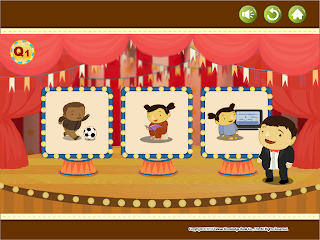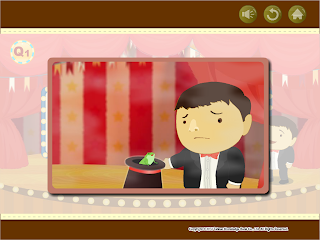Looking for more Mandarin practice to help your student review this summer? I'm still gathering materials to help my daughter emerge from summer vacation a happy, well-rounded, and rested 6 year old, who still happens to remember the majority of what she picked up in Mandarin class this year. I'm not sure how the children would feel reviewing their textbook all summer, when the teachers have already thoroughly covered it with them this year, but I do like the idea of using the same material presented in a different format. I recently discovered that Chinese Wonderland has a second app for children who have gone through the Level 1, traditional Chinese, textbook. The only real downside is that it appears to be for iPads only. It's a board game format, where a die is rolled and you advance around the board completing various tasks that review the material presented in the Level 1 textbook. Each spot on the board has a different task and you can land on the spot several times before repeating the same material.
The format is such that it works well for students to do it unsupervised, which means a nice break for me. Cute animation and virtual "stickers" help keep the children motivated. I picked this up for $.99 (It's also been free off and on), and use it with Cilla along with the other Wonderland app. I highly recommend it.
A place for parents, students, and teachers involved in the after-school Mandarin program at Dianne Feinstein Elementary School
Wednesday, June 26, 2013
Tuesday, June 18, 2013
Chinese Wonderland App


Sometime near the beginning of the school year I discovered that the company that produces Chinese Wonderland, the textbook the children used in Level 1 Mandarin, makes apps for use on the iPhone and iPad. I purchased Level 1, traditional Chinese, and used it sporadically with Cilla throughout the year. It follows the same curriculum as the textbook and offers supplementary practice with the same vocabulary and structures (so there's nothing really new here, though the dialogues are somewhat different from those presented in the textbook). It's fairly well-done, but we didn't use it often, mostly because there wasn't much to do with each chapter (You can finish a chapter in 5 minutes), and so, with an already busy schedule and other Chinese homework to complete, we simply fell out of the habit of doing it.

This week, however, I've revisited it and I now see it as a nice tool for reviewing during the summer so that we do not lose all the progress we've gained. What I like is that it's the same stuff the children have learned but in a format they haven't yet seen, so it seems fresh. I also like that the vocabulary is presented in a sentence and you can make substitutions with other vocabulary in the sentence (You can change one of the words in the sentence and hear it read to you). I thought the textbook could have done a better job of encouraging the children to make new sentences by inserting different vocabulary into basic sentence structures, so it was nice to see this feature on the app.
Other notes and tips:

This week, however, I've revisited it and I now see it as a nice tool for reviewing during the summer so that we do not lose all the progress we've gained. What I like is that it's the same stuff the children have learned but in a format they haven't yet seen, so it seems fresh. I also like that the vocabulary is presented in a sentence and you can make substitutions with other vocabulary in the sentence (You can change one of the words in the sentence and hear it read to you). I thought the textbook could have done a better job of encouraging the children to make new sentences by inserting different vocabulary into basic sentence structures, so it was nice to see this feature on the app.
Other notes and tips:
- I bought the app for $2.99, but as with many apps, the price can fluctuate. I have since seen it for $.99.
- Encourage your learner to sometimes try to read aloud the words and sentences before listening to them. After listening, say the word or sentence again for more pronunciation practice.
- The app allows you to see characters, pinyin, and English together. Although this can certainly be helpful at times, it is important for the children to be able to read the Chinese characters without seeing the pinyin and to be able to understand the meaning without seeing the English. It would be nice if there were a way to hide the pinyin, English, and characters, but there doesn't seem to be. In some places, you can scroll down slowly so as not to reveal the pinyin or Engish translation until you're ready; in other places, hiding this info is more difficult.
- Encourage your student to read the Chinese characters first whenever possible. If she doesn't know the sound the character makes, then have her look at the pinyin and read that if she is able. Likewise, avoid looking at the English translation unless your child really does not know what something means. Requiring an English translation at every turn can sometimes impede the flow of the Chinese ( and it really isn't as necessary as we are trained to think it is) , so sometimes let things go without asking for one.
- You can certainly let your little learner loose to do the app on her own, but there are certain benefits to sitting down to do it with her from time to time. That way you can make sure she gets the maximum benefit from it.
Tuesday, June 4, 2013
Liǎng zhī lǎohǔ
 The Two Tigers song was introduced to the children all the way back at the beginning of the school year and was performed at the DFES Mandarin graduation. Originating in Taiwan, Liǎng zhī lǎohǔ is sung to the tune of the French song Frère Jacques. Here are the pinyin and English lyrics and a cartoon clip of the song. Note that some versions of the song seem to use "eyes," while others use "ears." Students should be able to swap out one word for another since they have learned both words in class.
The Two Tigers song was introduced to the children all the way back at the beginning of the school year and was performed at the DFES Mandarin graduation. Originating in Taiwan, Liǎng zhī lǎohǔ is sung to the tune of the French song Frère Jacques. Here are the pinyin and English lyrics and a cartoon clip of the song. Note that some versions of the song seem to use "eyes," while others use "ears." Students should be able to swap out one word for another since they have learned both words in class.For extra practice: Can you sing the song by replacing the Mandarin words for eyes/ears and tail with the Mandarin words for other body parts like hand, foot, shoulders, knees, head, toes....?
Liǎng zhī lǎohǔ,
Liǎng zhī lǎohǔ,#
Pǎo de kuài,
Pǎo de kuài,
Yī zhī méiyǒu yǎnjīng,
Yī zhī méiyǒu wěibā,
Zhēn qíguài,
Zhēn qíguài.
Two Tigers, Two Tigers, Run so fast, Run so fast, One has no eyes, One has no tail, So strange, So strange.
Pángxiè: Crab Rhyme!
A while back, the students learned a rhyme with gestures about a crab. After some research, I discovered that this rhyme makes a surprise appearance in the movie "Shanghai Noon," with Jackie Chan and Owen Wilson. The rhyme has been changed up a bit there and the scene is not particularly suitable for children, so I used the pinyin and character information a helpful youtube commenter provided to hunt down some other versions of it. Below are several clips of the crab rhyme. The middle clip is a group of adults performing the short rhyme with the gestures. The first is a short soundtrack which includes the crab rhyme, followed by the same rhyme set to a tune. Finally, the third video showcases some young children in adorable crab costumes dancing to the rhyme and some music. The pinyin and English translations are below.
páng xiè yī yā zhǎo bā gè,
liǎng tóu jiān jiān,zhè mó dà de gè,
yǎn yī jǐ yā,bó yī suō,
pá yā pá yā guò shā hé。
螃蟹一呀,爪八個,
兩頭尖尖,這麼大的個,
眼一擠呀,脖一縮,
爬呀爬呀過沙河。
One crab with eight feet and pointed horns - what a big crab
Blinking eyes, shrinking head,
crawling, crawling everywhere.
páng xiè yī yā zhǎo bā gè,
liǎng tóu jiān jiān,zhè mó dà de gè,
yǎn yī jǐ yā,bó yī suō,
pá yā pá yā guò shā hé。
螃蟹一呀,爪八個,
兩頭尖尖,這麼大的個,
眼一擠呀,脖一縮,
爬呀爬呀過沙河。
One crab with eight feet and pointed horns - what a big crab
Blinking eyes, shrinking head,
crawling, crawling everywhere.
Subscribe to:
Comments (Atom)







